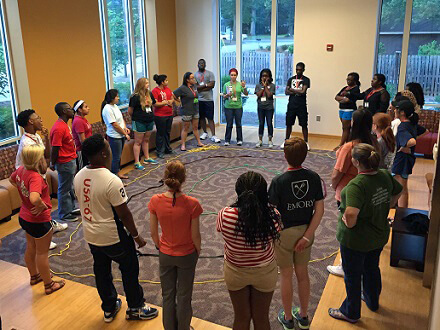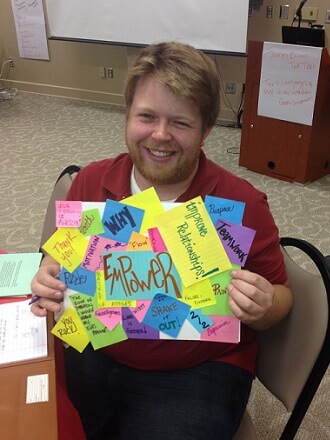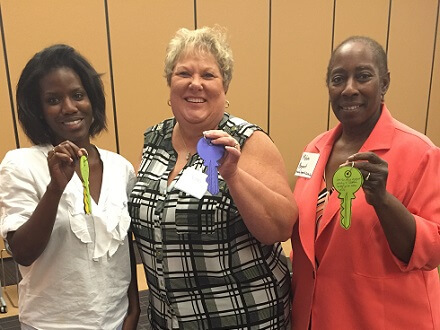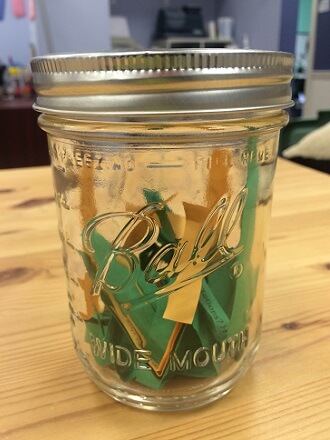“A defining condition of being human is that we have to understand the meaning of our experience.” – Jack Mezirow
 Reflection is a cognitive process that strengthens our ability to organize new information in order to gain greater meaning and understanding. By reflecting on an experience, youth and adults are more able to accurately recall what happened and how it made them feel as well as determine how to use those feelings in the future. As such, it’s imperative to consistently incorporate reflection in your program or organization. You can create reflection opportunities after team building activities, throughout lessons and even during staff meetings. By doing so, you are able to facilitate your participants’ learning process, enabling them to grow from the experience and determine how to apply it in the real world.
Reflection is a cognitive process that strengthens our ability to organize new information in order to gain greater meaning and understanding. By reflecting on an experience, youth and adults are more able to accurately recall what happened and how it made them feel as well as determine how to use those feelings in the future. As such, it’s imperative to consistently incorporate reflection in your program or organization. You can create reflection opportunities after team building activities, throughout lessons and even during staff meetings. By doing so, you are able to facilitate your participants’ learning process, enabling them to grow from the experience and determine how to apply it in the real world.
Including reflection may seem difficult, especially if you aren’t used to integrating it on a regular basis. Follow the techniques below to get started!
Debriefing Questions: One way to easily incorporate reflection is by asking your group debriefing questions during or after an activity. The Experiential Learning Cycle, developed by David A. Kolb, maps the debriefing process and allows you to customize the conversation to fit the needs of your group. Use at least one question from each debriefing stage to create a reflection experience for your participants:
- What (Concrete Experience): What happened? What did you experience? What did you see, hear, smell or touch? (As the facilitator of the conversation, refrain from evaluating or interpreting during this stage.)
- Gut (Reflective Observation): What feelings came up for you during the experience? When were you surprised? Frustrated? Pleased? Affirmed? Disappointed? What past experiences feel similar to this?
- So What (Abstract Conceptualization): What did you discover about yourself? Where did you have problems? Why? What do you understand differently now? How does this relate to larger ideas?
- Now What (Active Experimentation): What will you do with what you’ve learned? How will you apply it to your work, education or life? How can we support each other?
Reflection Activities: You can also incorporate fun, creative projects to get participants thinking about what they’ve experienced, or even help them to better engage in reflection with youth they serve. Below are some easy activities that your participants are sure to love!
Word Cloud Summary
 Materials Needed: Half-size sheets of poster board, markers and varying sizes and colors of Post-its
Materials Needed: Half-size sheets of poster board, markers and varying sizes and colors of Post-its
Directions: Prior to the activity, lesson or workshop, spread out the materials on the table(s). Plan specific times to stop the activity and ask participants to write down one new thing they’ve learned on a Post-it. The size of the Post-it should represent how significant they deem the new learning (e.g., an idea that really resonated with them should go on a larger Post-it). After participants write down this information, have them place it on a piece of poster board. They will continue to add Post-its throughout the activity or workshop in order to create a Word Cloud. At the end, have participants share their Word Clouds with the rest of the group, emphasizing the most important things they learned.
Key Notes Reflection
Materials Needed: Pre-cut, hole-punched cardstock keys, scissors, small binder rings and writing utensils
 Directions: Prior to your workshop or activity, cut out and hole punch three keys per person on various colors of cardstock. Determine three times during your workshop or activity where participants will stop and reflect (e.g., if you’re covering four concepts, have participants break after learning about the first and second concept, after the third concept and at the very end of the workshop). During each reflection break, have participants answer one of the following questions on one key:
Directions: Prior to your workshop or activity, cut out and hole punch three keys per person on various colors of cardstock. Determine three times during your workshop or activity where participants will stop and reflect (e.g., if you’re covering four concepts, have participants break after learning about the first and second concept, after the third concept and at the very end of the workshop). During each reflection break, have participants answer one of the following questions on one key:
- What have you been reminded of today?
- What have you learned today?
At the end of the workshop, have participants put all of their keys on a binder ring and keep as a take away to remind them of what they learned. You can also have participants stand in a circle and quickly share their biggest take away from the day.
Reflection Jars
 Materials Needed: Ball jars, reflection questions handout, blank slips of paper, circular labels (for the tops of the jars), markers, writing utensils and scissors
Materials Needed: Ball jars, reflection questions handout, blank slips of paper, circular labels (for the tops of the jars), markers, writing utensils and scissors
Directions: Have participants select 5-7 ideas from the reflection questions handout, cut them into slips and put them in their reflection jars. They can also write their own reflection questions and add them to the jar if they like. After the participants fill their jars, have them decorate a label to place on the top. Allow participants to take their Reflection Jars with them to serve as a resource any time they are leading an activity.
These are just a few examples of ways to integrate reflection with your group. What are other ways you’ve incorporated reflection with your Youth Action Team or staff? We’d love to hear from you!
